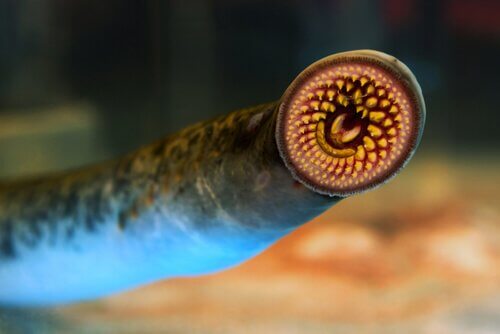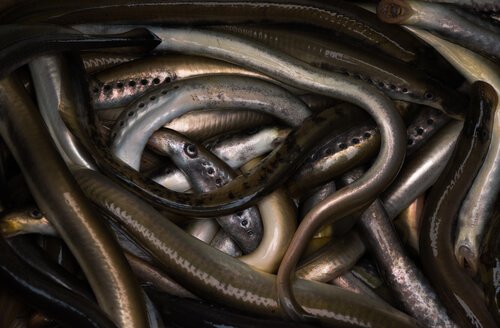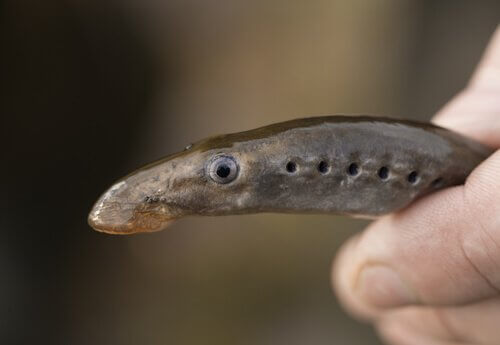The Sea Lamprey: Habitat and Morphology

The sea lamprey is a creature that really does showcase the incredible biodiversity around us. This species of jawless fish is very easy to recognize. Its fearsome appearance and hematophagous diet have earned it the nickname “sea vampire”.
Its mouth is surrounded by a kind of circular disc that works like a suction cup. It uses it to adhere to its prey, puncturing the skin and ingesting the meat underneath. This fish’s most distinctive feature is its rows of teeth and tongue.
They are anadromous fish, which means that you can find them in rivers during the first stage of their lives. Then, after that, they migrate to the sea to live out their adult life, eventually returning to the river to spawn their offspring.
What is the sea lamprey’s habitat like?
This peculiar specimen prefers North Atlantic waters, although it can also be found in the Baltic Sea. It lives in both seas and rivers, depending on which stage of life it is currently in.
A few years ago, you could find the sea lamprey in the Spanish regions of Andalusia, Catalonia, Aragon, and Extremadura. However, commercial exploitation has reduced its habitat. Nowadays, it’s more commonly found in Galician waters, to the north of Spain.
There are 40 species of lamprey, distributed among the different seas and rivers. However, at the beginning of their lives, the larvae remain buried at the bottom of a river. There they obtain nutrients, and feed on the organic matter that seeps into the area where they lie. They remain as larvae for three to five years, until they undergo metamorphosis. This then allows them to adapt to the marine environment.

Once they have gone through all the physiological changes for this new stage, they move to the depths of the sea. They live about 1000 to 2000 feet deep, and stay there for about four years. During that time, a second metamorphosis occurs that forces them to leave the sea and return to the river. It is there where they will give life to a new generation of lampreys.
Usually, the lamprey prefers wide rivers that are not very fast-flowing. They often choose the middle sections of those rivers. Pollution and an increase in artificial barriers has affected its life in the North Atlantic.
Morphology of the sea lamprey
The sea lamprey is a primitive jawless fish very similar in appearance to eels. In the larval stage, they can measure up to 20 centimeters in length. When migrating to the ocean in adulthood, they grow up to one meter in length, and weigh between two and three kilos.
The larvae differ drastically in morphology to the adult lampreys. They lack teeth, are blind, and have a feeding mechanism that works in a different way. They have a fringe of tiny, beard-like tentacles that they use to capture smaller life forms that serve as food.
At the end of the larval stage, they migrate to deep sea waters, and then the morphological changes typical of that period are evident. They develop large eyes with red spots, a pair of dorsal fins, seven gill openings, one nasal opening, a cylindrical greenish or earthy grey body, and the characteristic circular mouth with small, sharp teeth.

Other physical characteristics
The sea lamprey has no scales, its body is smooth and gelatinous, and its tail ends in a point. Its skeleton is cartilaginous, and it lacks bony parts. It has a very complete life cycle, returning to the rivers to reproduce. That is where people fish for them for consumption.
The sea lamprey is one of the least evolved species of animals known to man. They are supposedly around 500 million years old. As parasites, they have wreaked havoc on the population of marine species such as cod and hake.
When they migrate back to the rivers, they go through other morphological changes, including atrophy of the digestive system, the appearance of secondary sexual organs, and the degeneration of visual organs.
However, they still manage to follow the river’s flow, and use their cup-like mouths to drag along stones that they will use to make a nest for their offspring. Once they do that, they start spawning, thereby beginning a new life cycle.
People often catch lampreys by placing nets in line with a river’s current, trapping them when they follow the river in order to spawn. There is also a technique in which a fisherman stands on a boat or on the riverbank and spears the lamprey with a long rod with a trident on the end of it.
This species is used to prepare a well-known dish called lamprey a la Bordelaise, made by cooking the fish in its own blood. It has become a typical dish of Galicia, Spain.
All cited sources were thoroughly reviewed by our team to ensure their quality, reliability, currency, and validity. The bibliography of this article was considered reliable and of academic or scientific accuracy.